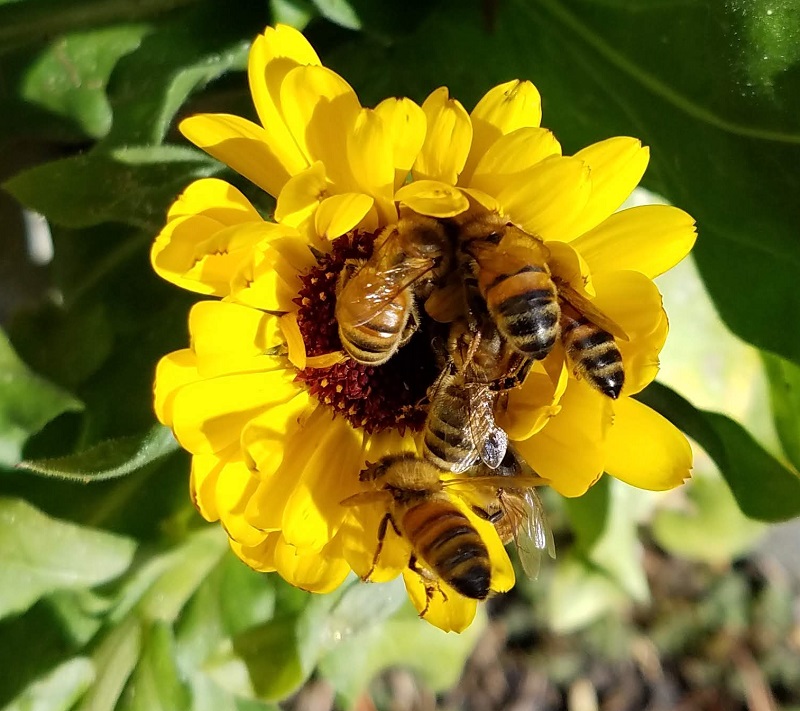Back in fall, I read a post on Pinterest that recommended using honey as a root stimulator. The link to that post is no longer active, but I did find another resource from Gardening Know How this morning. I believe the recipe I used listed two tablespoons of honey, while this one only uses one, but I may be wrong.
I really didn’t think this would work, but I tried it anyway, using honey that I didn’t want to bottle because it came from cleaning wax cappings. I mixed the honey and water in a mason jar, pulled leaves off lavender cuttings and scored the stems a little and then dropped them into the mason jar while I continued my search for leggy lavender. Most of the cuttings therefore soaked in the honey water for at least 20 minutes before I unceremoniously stuck them into a planter.

When the sun finally came out last weekend, my patience ran out and I just had to dig up the first cutting! To my surprise, it had around 3 inches of roots from all around the stem. Not all of the cuttings were quite that successful, but every one had enough of a root system to transplant it. I thought briefly about moving them to individual pots for another six months of babying, but the more cuttings I dug out with fantastic roots, the more work that seemed to be. We now have an additional 30 plants along the driveway. Now, not all of them may survive, but the exciting thing for me is that every cutting had roots. In the past, I’ve had anywhere from a 50 – 75% success rate using the same process but with store-bought chemicals.
I dug up two gardenia cuttings yesterday, but those are not yet as successful. Still, gardenia cuttings have always taken longer to root and had a lower success rate than many of the other plants I’ve propagated. I moved them from the greenhouse to outdoors and will leave them alone until the weather turns hot. At that point, they’ll stand a better chance of surviving in individual pots or in the ground. When I transplant them, I’ll douse them with honey water to give the roots another helping hand – maybe.

Spring is in the air for the bees, too! The pollen feeder and syrup feeders are abuzz and the lonely calendula blossom above was covered in bees all day long. I sowed calendula seed too late last year but managed to get a handful of plants started in pots. They have bloomed throughout the winter and survived temperatures as low as 23 degrees. Not only are they a great resource for bees at a time when not much else blooms, calendula blossoms are reputed to aid healing for a variety of skin conditions. I use calendula blossoms in the anti-itch salve that I make and have used calendula-infused olive oil in one batch of soap so far. I hope to get enough growing this spring to have plenty for the bees and me to share. From what I’ve read, calendula will readily self-seed and grow in even the poorest soils, so I just need to get some going, leave some flowers to go to seed, stop the chickens from eating them, and stop the cat from digging them up to poop in the flower pots!
Well, the sun is out and the thermometer is rising, so it’s time to leave the computer and head outdoors! I don’t think I’ll be throwing any more mulch around with a pitchfork today, but there are some less strenuous garden and bee chores I can tackle. There are always plenty of reasons to get out an enjoy the sunshine here on the farm, and there will be time enough to do laundry after sunset.
Interested in what you used to mulch the lavender.
LikeLike
We chipped pine branches last weekend, and I put those around the lavender but left space between the plants and the mulch. The lavender here is up on a berm, so drainage is not an issue. We had to move most of our lavender last fall because they were not doing well on level ground with a high clay content, but the ones planted on slopes are doing great. I have just enough mulch down to make weeding easier, but no so much that the lavender roots stay wet.
At our old house, we had sandy soil and mulched with store-bought cedar chips. Even with the sand, the lavender didn’t do well when the mulch retained too much water.
LikeLike